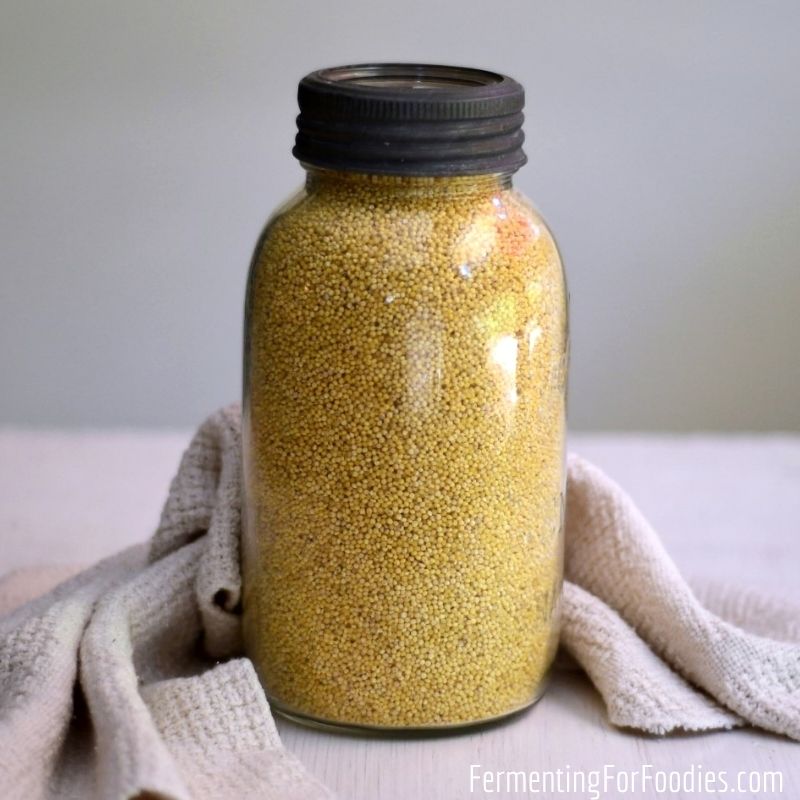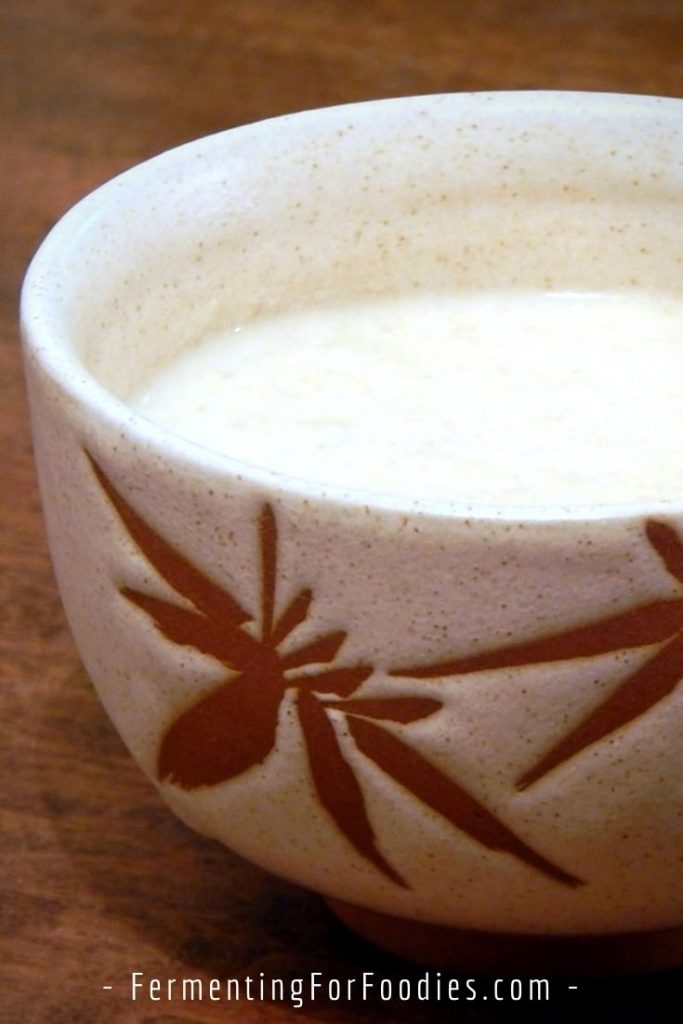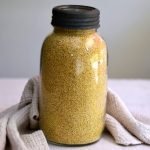Fermented millet porridge is a traditional breakfast in a number of countries spanning Europe, Asia, and Africa, where millet is an affordable and sustainable crop.

Fermentation improves the digestibility and increases the nutritional value of the millet, for a wholesome breakfast option. It’s also gluten-free, wholegrain, vegan, and zero-waste!
Types of fermented millet
The recipe below follows a method similar to that of Nigerian Ogi. The millet is milled before fermenting, which results in a very smooth and creamy cereal.
- Whole fermented millet is not ground before fermentation. The texture after cooking is similar to polenta. It also makes a nice, thick porridge.
- Dosas are South Indian-style crepes that can be made from fermented lentils and millet.
- Ragi Malt is a thick beverage made from millet flour. It can be fermented after cooking for improved digestibility.
Types of Culture
Like most grains, millet naturally ferments from the wild yeast cultures in your home. If you are new to fermenting, it can take a while to catch the wild yeasts. However, the more you ferment, the more wild yeasts you’ll naturally have in your home.
If you’re struggling to catch a wild ferment or if it’s your first time fermenting grain, then I recommend using a starter culture to get everything going. Any yeast-based fermented beverage will work.
- kombucha
- water kefir
- milk kefir
- jun
MilIet porridge mixed with an additional culture should still be left to ferment for 2 to 3 days. Then cooked according to the recipe.

Millet porridge
Fermented millet porridge is a traditional breakfast in Asia, Africa and Russia. Fermenting millet improves the digestibility of the grain and increases the nutritional value.
- Prep Time: 20 minutes
- Cook Time: 20 minutes
- Total Time: 40 minutes
- Yield: 4 cups 1x
- Category: Breakfast
- Method: Fermented
- Cuisine: Nigerian
- Diet: Gluten Free
Ingredients
- 1 cup of millet
- 5 1/2 cups of water (divided, chlorine-free)
- 1 Tbsp culture (optional, see section above for details)
Instructions
- Soak the millet in 2 cups of water for 24 hours. This will soften the millet and start the fermentation process.
- Drain the water from the millet, then grind it into a smooth paste.
- Mix the millet paste with 1 cup of water and put it in a glass bowl or jar for fermenting. You can add 1 Tbsp of culture at this point, but it isn’t required (see the section above for details). Cover with a tea towel and leave the millet to ferment in a warm location for 2-3 days. Stir at least once a day. After a few days, it will bubble and start to smell sour.
- To cook fermented millet porridge, scrape the millet paste and fermentation liquid into a pot. Mix with an additional 2 1/2 cups of water. Slowly bring to a simmer and cook for 15-20 minutes, stirring frequently. It will be very soft and creamy, with an almost gel-like consistency, when finished.
Notes
- Use a food processor or blender
to grind your millet.
- Ogi is traditionally quite soupy, if you want it thicker, more like cream of wheat, then reduce the cooking liquid by 1/2 cup.
- Millet porridge is perfect for all your favorite porridge toppings. Serve it with fresh or dried fruit or jam.
- Leftover ogi can also be added as a thickener for soups and stews.






Would you happen to have the nutritional information for this recipe?
Sorry, I don’t have info for how fermenting changes it. But here’s wiki’s nutrition profile: https://en.wikipedia.org/wiki/Millet#Nutrition
Hi, if anyone is interested, another place I sometimes like to find nutrition information is on a website called myfooddata.com
One of the tools on this free website (free as of April 2024 when I’m writing this) is a recipe nutrition calculator (under the “tools” menu) that lets you add ingredients, if you want to know the totals for a few ingredients or even an entire day’s food.
They get most of their data from the usda, but I find the site a little easier to navigate than the usda site
Thanks for sharing! I also can provide nutrition data in my recipe card, but I tend to avoid it with fermented recipes. The issue is that the nutrition data changes the longer something ferments! 🙂
I would like to know, if this is cooked, doesn’t the bacteria get destroyed?
I am specifically talking about the very beneficial Saccharomyces boulardii bacteria.
Yes, heating will kill the bacteria. In this traditional ferment, the fermentation is to improve the nutritional value of millet by breaking down the complex carbs. You could ferment after cooking for probiotic millet.
This may not be relevant, but I saw a study that claimed that even store-bought sauerkraut with inactive culture had health and gut health benefits because it still contained the good “metabolites” made by the good bacteria during the ferment
There are enzymes associated with fermented foods that are helpful. 🙂
I like the recipe!
Very Nice.
THanks! Do you know if you can use S Boulardi as the starter culture?
Hum, I’ve only done this as a wild yeast ferment. However, kombucha is a great fermentation starter for grains, so probably S. Boulardi is also good at fermenting grains. If you try it out, let me know how it goes!
Hello! Re you using hulled millet for this, or in hulled? I am looking for ways to cook unsullied millet. Thank you
Sorry, autocorrect got me ….“UNHULLED”
This recipe can be made with hulled or unhulled millet because it is soaked then ground. Enjoy!
My Family Loved it. I am definitely sharing Guys, Thanks For sharing this Great Recipe. this recipe and this website with my friend. Hope they also love it. Thank you again for sharing such a great recipe.
Thanks!
This looks great – I reckon I could probably use sourdough starter as a culture, if it needs to be yeast-based?
Ogi is usually made with a wild culture caught. However, you could use sourdough starter. Quite likely it would involve similar strains of yeast and bacteria. Enjoy!
Hi
I love your blog!
I started to make my own simple glutenfree bread from fermented rice. I made many great breads, but the last one didn’t sucess.
Normally I stir in some salt (like a teaspoon to 300g rice), cover with water and a towel and let the rice ferment about two days. Then I mixed it well in a blender and let the dough ferment again for a half day.
Normally the ferment smelled good, like good fermentation. The last time I let the raw rice sit for three days and the smell was very unpleased, there was a sharp disgusting smell so that I had to discard the rice. 🙁
Do you have experience with fermented rice? Do you ferment it just like millet?
Hi Anna! I’m glad you can tell the difference between a good ferment and a bad ferment. The smell is important. If it smells bad, it is bad.
I haven’t tried the fermentation procedure that you describe. Generally, when I ferment raw grains, I use filtered water, without salt. For bread, I usually use filtered water and flour. With cooked grains, I use some sort of starter to ensure a good ferment. The issue with cooked grains is that they don’t have a natural culture (found in raw grains and flour). So there is a risk of culturing the wrong types of yeast and bacteria, the kind that cause food to rot rather than ferment.
I imagine you are fermenting cooked rice? That might be why you had an issue. Cheers, Emillie
Hi Emillie thank you a lot for your reply!
I actually always did it with raw rice to use the bacteria that is already naturally on the grain. The water in my country is fortunately not chlorinated. I was very unsure about the salt but thought that it might make the conditions better for fermenting, like I use to make it with cabbage for example. But next time I will try without salt, too!
I made the bread like that several times and was always very happy with the complex aromas from the fermentation. Then, when the last fermentation went wrong, I googled how to ferment raw rice properly but unfortunately couldn’t find anything. My problem with my procedure is, that now I’m a bit afraid of pathogenic bacteria that don’t show themselves via smell. (As long as they are in low concentration).
But at least this is how I found your really great blog with so many interesting recipes! 🙂
Wild fermentation of raw rice is definitely better than cooked rice. I do ferment raw rice for dosas: https://www.fermentingforfoodies.com/homemade-rice-dosas/ I just haven’t started bread that way. Glad you enjoy the website! Cheers, Emillie
Hi Emillie, I’ve followed the instructions, and after 3 days of fermenting, the fermenting millet smells quite foul. There’s like a mouldy film on top of the ferment. How do I know whether I can still use this? Can I scoop off the mould and continue with cooking or start over? My kitchen is around 16-17 degrees in winter, is that too cold / too slow for the ferment perhaps? Thank you, kind regards, Els
Sorry, it is 16-17 degrees celcius, just to be clear!
Hello Els, sorry to hear you’ve had issues with your ferment. If the scum on top is mold, then you’ll have to throw it out. However, if it’s kahm yeast, you can simply cook with it. Here’s a post so you can learn to tell the difference: https://www.fermentingforfoodies.com/kahm-yeast-mold/
A cold temperature isn’t ideal for fermenting (unless it’s certain types of beer or wine!). Can you move your ferments to somewhere warmer? Above the fridge, near your hot water tank, or a room you keep to around 18-20C is ideal. Also, if you have mold in your house, that increases the likelihood of mold in ferments. In that case, use a lid on your ferments, not just a cloth. If the millet is raw, natural millet, then it will have the culture needed to ferment. If you aren’t sure, then add a bit of culture to help things along.
Hope this helps! Emillie